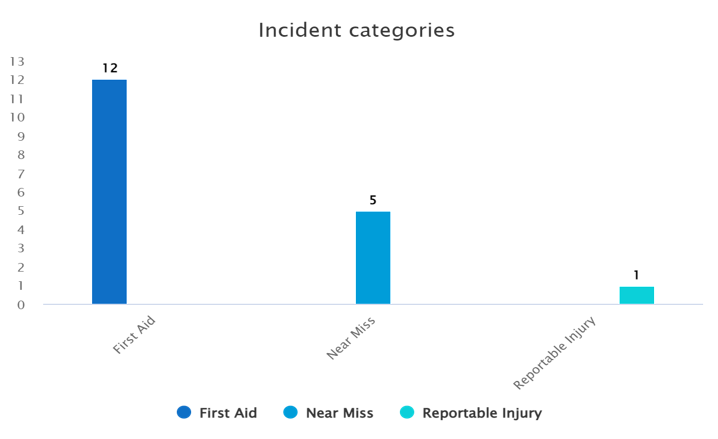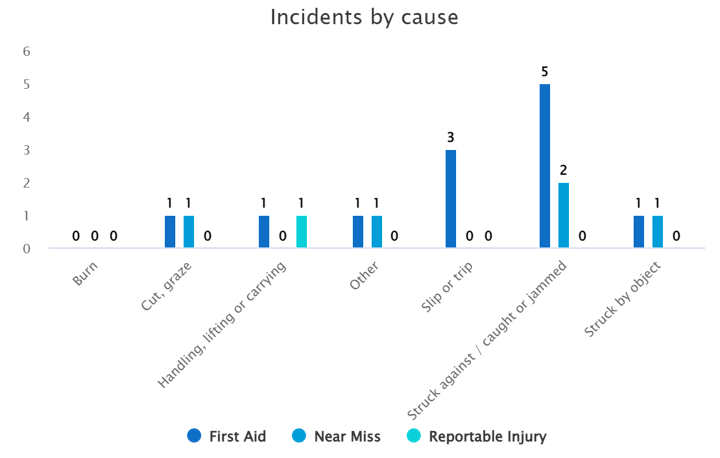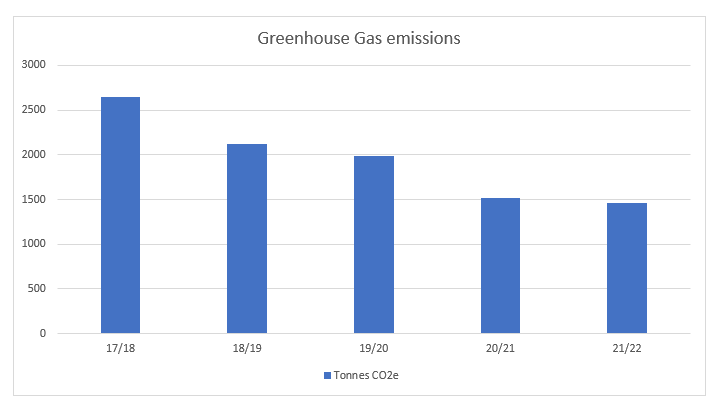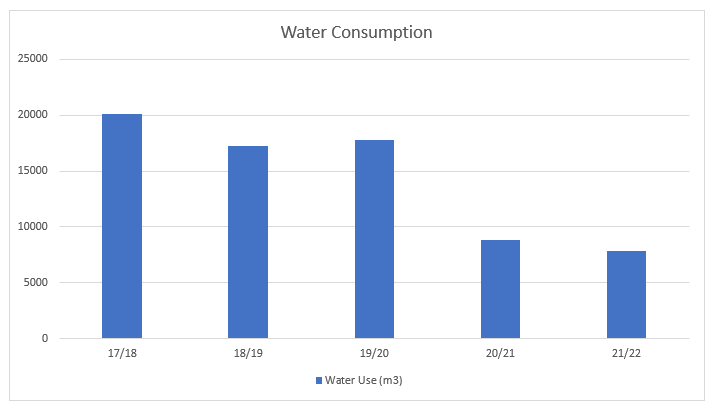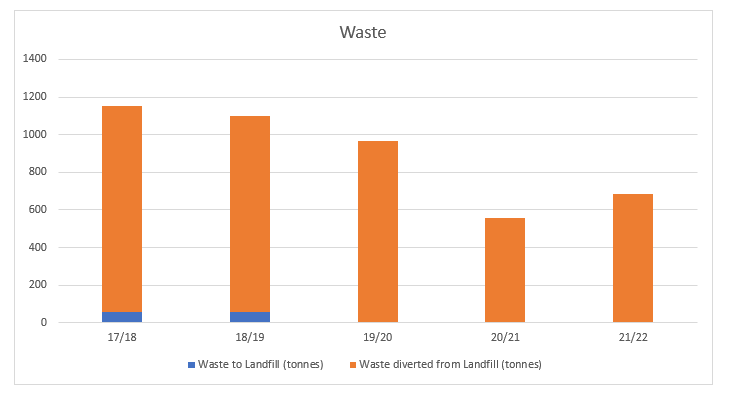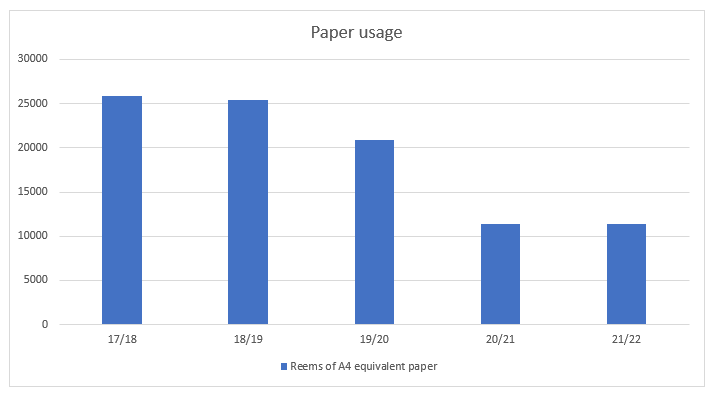Jump to:
Introduction from our Executive Director of People and Corporate Services
This report celebrates what we have achieved during 2021-22. It was another challenging year, but thankfully we did see the end of the UK’s legislative controls in relation to the coronavirus pandemic. The pandemic required all of us to make huge changes to the way we lived and worked - and I’m again hugely proud of the fact that the health, safety and wellbeing of our colleagues was the top priority of our organisation. You’ll see details throughout this report of how we worked collaboratively across our business to make sure this priority was delivered day-in, day-out for all our colleagues - whether they were working at home, or in our offices and warehouses.
As a business we continued to act to address one of the other biggest challenges faced by society, with climate change and the environmental degradation continuing to be an issue across our planet. This report demonstrates how serious we are about this threat, and how all of our services are stepping up to support our Climate Emergency declaration and to achieve Net Zero as a business by 2030.
Whilst we recognise that we still have lots to do in relation to both post-pandemic ways of working and protecting our environment, this report aims to demonstrate what we have achieved to over the last twelve months and celebrate the hard work, passion and commitment of our colleagues and partners.
Mark Dibble
Executive Director of People and Corporate Services
About us
We are an Arm’s Length Body of the Department of Health and Social Care (DHSC). We are responsible for providing platforms and delivering services which support the priorities of the NHS, Government and local health economies and in so doing we manage around £39 billion of NHS spend annually.
By providing these services nationally and at scale, and by digitising services and utilising leading-edge technology we deliver great taxpayer value, providing huge savings for the NHS which can then be reinvested in frontline care.
Our purpose, strategic goals and values (see Our Strategy for more details) complement and support our commitment to achieving high standards of health and safety, maximising our positive impact on the environment and driving resource efficiency - with one of our seven strategic goals being specifically focussed on ‘Our People’ and another on ‘Environmental Sustainability’.
We also recognise that health and safety, and environment and resource efficiency require specific focus, with targets and objectives set to address key areas linked to our operations and the social value we can bring. During 2021-22 these were outlined in our Health and Safety Strategy and Action Plan, and Environment and Resource Efficiency Strategy and Action Plan.
Our journey so far
Each year we continue to integrate our approach, ensuring that the material issues and needs of our customers, clients and others inform what we deliver and how we deliver it. Read some of the key points on our Safety Health and Environment journey since the formation of the NHSBSA in 2006.
Governance, assurance and oversight
During 2021-22 our Executive Director of People and Corporate Services was the Senior Responsible Officer (SRO) for SHE as delegated by our Chief Executive. He ensured that the organisational arrangements and resources were in place to meet our responsibilities and achieve our aims and objectives.
Progress was reported and monitored at Leadership Team and Board level in regular reports. We also had in place a non-executive director SHE champion providing oversight of the agenda. Likewise, update reports were provided to our staff at regular intervals through various channels including the internal newsletter, Chief Executive’s blog, intranet and business communication tools, live Q&A sessions and notice boards.
Formal consultation and engagement were via our National Joint SHE Committee, with local groups overseeing implementation in each team.
Additional methods used for assurance over our approach and our data were:
- SHE Management System - Our internal policies and procedures, ensured a transparent, systematic and controlled approach to our SHE activities.
- Environmental Management System (EMS) certification - Externally certified to the ISO 14001:2015 standard. During 2021-22 we successful maintained certification of our business-wide EMS system.
2021-22 saw the launch of the NHSBSA’s Corporate Governance Dashboard, which includes performance data for both health, safety and the environment. The dashboard provides a source of both live and historic performance data and enhances the NHSBSA’s transparent approach to the reporting of this data.
Public reporting undertaken using the following methods:
- NHSBSA Annual Report and Accounts - Contained information and commentary on our performance, including that required by HM Treasury in Public Sector Annual Reports: Sustainability Reporting guidance.
- Safety, Health and Environment (SHE) Annual Report - A more detailed report giving an overview of governance arrangements, performance and key activities.
Health and safety
Overview
During 2021-22 health and safety was managed and coordinated by our central SHE Team, made up of qualified and experienced health and safety professionals. The team was supported by health and safety representatives in each business area who were trained, coached and supported to ensure they had the appropriate skills and knowledge to oversee local delivery of our policies and processes.
Health and safety Performance review 2021-22
Total accident, injury and near miss reports during 2021-22
Reporting of Injuries, Diseases and Dangerous Occurrences Regulations 2013 (RIDDOR) reportable incidents are certain serious work-related accidents, occupational diseases and specified dangerous occurrences which require formal reporting to the Health and Safety Executive (HSE).
A first aid treatment injury is defined as any one-time treatment or follow-up visit for the purposes of observation of minor injuries which do not ordinarily require medical care provided by a professional physician.
A near miss is an unplanned event that did not result in injury, illness or damage, but had the potential to do so and was only avoided by circumstance or good fortune.
Injuries and near miss by cause for 2021-22
During 2021-22 the NHSBSA had one case which needed to be reported to the Health and Safety Executive (HSE) under the Reporting of Injuries, Diseases and Dangerous Occurrences Regulations 2013 (RIDDOR). This number of reportable events is very low for a business of our type and size, when compared to published HSE figures. We believe that this is a result of our proactive approach to health and safety, ensuring all our people are involved, supported and understand their role in how we look after ourselves and those around us.
Prevalent injury types remained consistent, with minor cuts and grazes, general slips and trips and staff striking against objects. Note: The “Other “category is used to report injury types that do not have a predefined category, for example allergic reactions and certain occupational health conditions. Across 2021-22 this number remained consistent with previous years.
The business continues to see a small number of ill health conditions reported by home workers (13 total - 5 home workers and 8 site-based - 2021-22), albeit still relatively low numbers and very similar to the previous pandemic year 2020-21 (12 total - 6 home workers and 6 site based - 2020-21). By comparison pre-pandemic year 2019-20 our workforce reported 65 ill health conditions whilst at work. The SHE Team have worked closely with colleagues to address and support their personal needs throughout the year whilst working from home.
Key areas of activity during 2021-22:
COVID-19 response
2021-22 saw the second and last year of legal and other restrictions relating to the COVID-19 pandemic. With over 90% of our employees being enabled to work from home during the first year of the pandemic, this arrangement largely remained the same across the second year. The SHE Team continued to work with the NHSBSA Technology Team and an in-house national distribution group to assess staff requirements and deliver items of equipment to employees to enable them to maintain working effectively and safely from home, as well as accommodating the needs of new starters and leavers within the business.
Controls were maintained for staff that were required to remain in our premises to maintain business critical services, which included:
An individual clinical assessment of susceptibility to COVID-19
Over the pandemic we assessed over 1,200 employees, over one third of our workforce. Requirements were assessed on a weekly basis to accommodate colleagues who were required to return home to work or who were required to return to one of our premises due to business needs, technical issues, or significant wellbeing issues.
Building occupancy management
Over the pandemic we set building capacities of no more than 30% occupancy, restructured desk space to support this and introduced an estate-wide desk booking process to manage and control building occupancy. The desk booking process was produced by NHSBSA internal IT resource and expertise and enabled us to further protect the health and wellbeing of staff that were required to remain in our premises and maintain business critical services.
The provision of bespoke reusable face coverings
Over the pandemic we supplied 16,000 reusable face coverings. These coverings were manufactured with around 90% recycled fabric content, and the ability to launder and reuse these coverings eliminated the need for the business to purchase what would have been more than one million disposable face masks.
The provision of free COVID-19 lateral flow testing
Over the pandemic we distributed over 3,000 lateral flow tests under the central government scheme to provide free twice weekly testing for NHS staff that were site based. This equates to over 1,500 working weeks covered by testing.
The controls put in place for all premises were assessed against government guidance on providing a COVID-secure business and this remained in place throughout 2021-22. COVID-19 restrictions ended in early 2022 with the revocation of the last remaining legal controls. The government’s “Living with COVID-19” strategy was introduced with guidance and controls implement across our estate.
The SHE Team shall continue to support the business as we transition into a hybrid way of working, whilst rationalising our estate and increasing the overall number of contractual home workers. The business will ensure risks are assessed and appropriate arrangements are put in place whilst supporting colleagues in their new way of working.
DSE / Homeworking Assessment App launched
The App, produced by NHSBSA internal IT resource and expertise, was launched to cover both office and homeworking, replacing previous e-learning module and paper forms. With the majority of the NHSBSA’s workforce working remotely the App proved invaluable in assessing employee home working and workstation arrangements, as well as providing business oversight of all NHSBSA home based assets.
Audits and inspections
In conjunction with the national Union representative and our Estates Team, we maintained our requirement to audit and inspect the workplace, ensuring the safety of colleagues working in our premises.
First aid and fire
The SHE Team have worked with local managers throughout the year to review local first aid and fire warden arrangements and recruit new personnel where appropriate, to ensure we maintained adequate cover for first aid and fire safety in our buildings.
Environment and resource efficiency
Overview
During 2021-22 our approach to environment and resource efficiency was managed and coordinated by our central SHE Team. The team was made up of qualified and experienced SHE professionals, including a subject-matter expert in the role of NHSBSA Environment Manager.
We continued to set and monitor corporate targets linked to our material risks, opportunities and the requirements set out in central government’s Greening Government Commitments, whilst maintaining our externally certified ISO 14001:2015 Environmental Management System.
Environment and resource efficiency performance review 2021-22
Throughout our performance review we have evaluated where our work supports the UN Sustainable Development Goals (SDG) and have indicated which goal using the relevant SDG tile.
Table 1 summarises our internal targets and performance up to the end of 2021-22. It should be noted that in many cases our internally set targets, aligned to our business strategy, stretch us much further than the mandated Greening Government Commitments (GGC) targets.
The new GGC scheme for 2021-25 aligns to cross-government policy and existing commitments and expands the number of headline commitments we need to report on centrally and sets a range of sub-commitments supporting key sections of GGCs.
GGC 2021-25 introduces more ambitious targets for core areas of greenhouse gas emissions, water, waste and paper and also introduces new measures for ICT and digital services, climate change risk and adaptation, biodiversity and food waste. The SHE Team have been working with stakeholders across the organisation to implement the GGCs.
The new scheme has changed the baseline year from 2009-10 to 2017-18. The NHSBSA made significant progress in the early years of the GGC scheme so the targets and revised baseline will make these commitments more challenging.
Environment and resource efficiency targets
The targets given are by the end of 2021-22, on a revised 2017-18 baseline.
| Targets | 2021-22 performance |
|---|---|
| 35% reduction in greenhouse gas emissions (Greening Government target: 44% by 2025) | 45% |
| 40% reduction in water consumption (Greening Government target: Reduce water consumption by 8% by 2025) | 61% |
| 30% reduction in waste generated (Greening Government target: Reduce overall amount of waste generated by 15% by 2025) | 41%* |
| Less than 5% of waste to landfill (Greening Government target: Less than 5% of waste to landfill) | 0%* |
| Increase the proportion of waste recycled to at least 80% of overall waste (Greening Government target: Increase the proportion of waste recycled to at least 70% of overall waste by 2025) | 90%* |
| 45% reduction in office paper use (Greening Government target: 50% reduction in office paper use by 2025) | 56% |
*Waste data relates to operational waste and excludes construction waste.
A detailed summary of our environmental and related financial data is given in the appendix, along with performance commentary, aligned to the requirements of HM Treasury Public Sector Annual Reports: Sustainability Reporting guidance. The following figures give a high-level summary of our performance against our new baseline year of 2017-18.
Greenhouse gas emissions
Greenhouse gas emissions data table
| Year | TCO2e |
|---|---|
| 2017-18 | 2,642.93 |
| 2018-19 | 2,124.80 |
| 2019-20 | 1,987.99 |
| 2020-21 | 1,519.62 |
| 2021-22 | 1,460.49 |
Greenhouse gas emissions chart
In 2021-22, we continued to see an increase in gas consumption because of our response to COVID-19. We have changed how we operate our air conditioning systems, to circulate fresh air instead of recirculating air, which has increased our heating demand and gas consumption throughout the winter months. Building occupancy remained low and less equipment running in our buildings has also increased heating demands across our estate.
Throughout the year we have also seen another increase in fleet travel, of around 15,000 miles, as a result of our response to COVID-19 with the distribution of homeworking equipment to enable our staff to comfortably work from home.
We have reduced our electricity consumption across our estate because of low occupancy levels across all sites as we have responded to COVID-19. Likewise, we have reduced our business travel significantly due to the pandemic - replacing face-to-face meetings with online meetings. The business is committed to learning from such positive changes, for example ensuring that unnecessary travel is not undertaken. Any increases in greenhouse gas emissions from increased gas consumption and fleet travel have been offset by reductions in electricity consumption and business travel.
Overall, we have continued to see a downward trend in our greenhouse gas emissions.
Water consumption
Water consumption data table
| Year | Water Use (m3) |
|---|---|
| 2017-18 | 20,090 |
| 2018-19 | 17,233 |
| 2019-20 | 17,785 |
| 2020-21 | 8,793 |
| 2021-22 | 7,853 |
Water consumption chart
We continue to see large reduction in our water consumption, when compared to pre-pandemic levels, as a result of our low building occupancy across 2021-22. Our Estates team continues to monitor water usage site-by-site and look at operational improvements where appropriate.
Waste reduction and diversion from landfill
Waste reduction and diversion from landfill data table
| Year | Waste to Landfill (tonnes) | Waste diverted from Landfill (tonnes) |
|---|---|---|
| 2017-18 | 59 | 1,095 |
| 2018-19 | 58.4 | 1,042.91 |
| 2019-20 | 1.48 | 964.20 |
| 2020-21 | 0.20 | 557.36 |
| 2021-22 | 0 | 682.83 |
Waste reduction and diversion from landfill chart
We have continued to make improvements to many of our services which has reduced our reliance on paper processes. We have continued to promote use of the Electronic Prescription Service (EPS) with over 90% of prescriptions being processed electronically, which has significantly reduced our paper waste. Furthermore, the “Manage Your Service” to prevent the introduction of paper forms has continued to be expanded throughout 2021-22. Due to reduced building occupancy as a result of COVID-19, we have seen a reduction in general office-based waste across all of our sites.
Construction waste from Greenfinch Way works has been excluded from all NHSBSA waste KPIs to allow for better monitoring of operational waste and shall be incorporated into this Annual Report year-end data tables for transparency.
Disruption caused by COVID-19 had increased the retention period of some paper records in scanning services, but with the resumption of services in 2021-22 waste generation increased when compared to 2020-21 but remains much lower than pre-pandemic levels.
With the introduction of digital exemption certificates, we eliminated the generation and circulation of over 2 million plastic cards.
We have continued to meet the Greening Government Commitments target of sending less than 10% of our waste to landfill through our waste management practices and contractual arrangements. We continue to monitor the growth of our business and on-boarding of new services, and the impact this will have on our waste figures.
Paper usage
Paper usage data table
| Year | Reams of A4 equivalent paper |
|---|---|
| 2017-18 | 25,869 |
| 2018-19 | 25,455 |
| 2019-20 | 20,858 |
| 2020-21 | 11,387 |
| 2021-22 | 11,405 |
Paper usage chart
We have continued to reduce our paper consumption within the business, primarily through the delivery of our service improvement programmes, by providing more digital options and increasing uptake of our digital solutions across many services. 2021-22 saw over 2 million employees receiving electronic payslips through Electronic Staff Records (ESR).
In Q3 2021-22 our Exemption Checking Services resumed which has increased the number of letters being issued when compared to 2020-21.
Key areas of activity during 2021-22:
Environment Strategy 2022-25
A new Environment Strategy has been written to reflect the increasing ambition and priority of environmental improvement at the NHSBSA. The strategy has been informed by industry best practice, requirements of mandatory Government policy and in consultation with key internal and external stakeholders.
Climate emergency
On 23 September 2020 the NHSBSA declared a climate emergency to recognise the risk posed by global warming and climate change. Throughout 2021-22 we have laid important foundations to build upon in the coming years. Our activity has continued to be overseen by the Environment Committee which has met on a quarterly basis and is chaired by our Chief Executive and attended by senior management. Furthermore, we have engaged stakeholders and have taken into account internal and external priorities to develop a longer-term ambitious Environment Strategy 2022-25 which will be launched during 2022-23 to support the delivery of the NHSBSA’s new corporate goal of ‘Environmental Sustainability’, also developed throughout 2021-22. We have also further engaged and supported our colleagues and leaders on climate action through the launch of a Climate Action Toolkit and bespoke environmental awareness sessions.
Established Net Zero target by 2030
Throughout 2020-21 we developed an estates carbon management plan supported by a Carbon Management Working Group to develop and oversee carbon reduction projects across our estate. Throughout 2021-22 we have worked closely alongside our suppliers to further develop, design, and cost a range of energy efficiency and renewable energy schemes that support our transition to Net Zero, including LED lighting schemes, solar photovoltaics and additional electric vehicle charging. The development of this suite of schemes will enable delivery of projects during 2022-23.
ISO 14001:2015
We successfully maintained our externally audited, business-wide Environment Management System during 2021-22. The operation of this standard has many benefits, such as helping us to ensure that we are legally compliant and continue to improve our environmental performance. The standard is also valued by our external customers and clients and demonstrates our commitment to environmental issues.
Environment Committee
Chaired by our Chief Executive and attended by senior management representing all areas of our business. The committee oversees and makes decisions relating to our environmental sustainability agenda.
Environment Network
Throughout 2021-22 our Network continued to engage with colleagues across the business through developing and running awareness campaigns on different environmental topics. Although the COVID-19 pandemic curtailed group activities, the Network continued their engagement activity adopting new ways of working, including the production of interactive guides on reducing water and energy wastage at home ,and supported World Wildlife Day.
Biodiversity survey
Using the biodiversity survey completed at our Stella House and Greenfinch Way sites, we have developed a biodiversity plan which sets clear direction for the improvements we intend to make across each of these facilities which will form part of our activities for 2022-23. We have continued to assess and expand our knowledge of opportunities to support biodiversity across our estate through the completion of a biodiversity survey at Hesketh House.
Communications & engagement
Throughout the year we have continued to engage the business on our environment commitments and compliance obligations. This year we have developed an identity and new branding for our environment programme to accompany all our environmental communications. Through the branding we aim to inspire and motive staff to become more involved.
We continue to utilise new communications platforms such as a new Intranet and an Environment Network community on our internal social media to engage and interact with our colleagues. Many of the channels we use to engage colleagues now allow for two-way communication where colleagues can respond, share best practice and ask questions.
Digitisation of our services
As part of our core business strategy, we are continuing to modernise and improve how we deliver our services. We are engaging with our customers and clients to improve the delivery of many of our services including those currently delivered using paper-based forms and admin-heavy processes. We have continued to develop and transform our services and continue to drive uptake of our digital services to remove waste and paper consumption at source. For example, we continued to engage with NHS organisations to encourage uptake of electronic payslips and throughout 2021-22 we reached over two million NHS employees receive electronic payslip through ESR; reducing the number of paper payslips we issue. Within our Help with Health Costs service, we have prevented over 2 million plastic cards from being issued by providing digital and paper-based alternatives.
Sustainable procurement
As of January 2021, the NHSBSA were required to explicitly consider Social Value in procurements and allocate a minimum of a 10% weighting of the scoring to Social Value.
The guidance references “fighting climate change” as a theme within the new Social Value Model. The SHE / Commercial Services team continue to assess procurements and introduce requirements and targets for suppliers to improve their environmental performance in accordance with the Model.
The Model guidance also refers to social value as being a “Golden Thread” throughout project management and business cases. The SHE/Project Management team are currently reviewing the project management process with the aim of improving how we consider and identify environmental impacts and improvements in-line with our net zero ambitions and government mandates.
As of September 2021, the Carbon Reduction Plans in the procurement of major government contracts Public Procurement Note (PPN) came into effect. This PPN requires suppliers, where spend exceeds 5 million pounds per annum, to commit to working towards Net Zero by 2050 and develop a Carbon Reduction Plan aligned to a standard Government template. The supplier is required to report on progress against the Plan throughout the performance of the contract.
Over the last year there has been a much greater emphasis within Government policy and the wider health and social care system on the importance of sustainable procurement and the added value that can be achieved through encouraging and mandating suppliers to improve their environmental performance.
The first supply chain engagement event was held in 2021-22 with 40 people in attendance. The event focused on driving environmental improvements throughout our supply chain and provided an opportunity to consult with key suppliers to understand supplier maturity with respect to environment and gain feedback on our environment supplier framework which is in development. Our first carbon footprint of the goods and services we procure has been completed and is currently being analysed. This is a significant step forward to better understand supply chain environmental impacts.
The SHE / Commercial Team continue to develop our Sustainable Procurement Plan which brings together and implements the requirements of the Social Value and Carbon Reduction PPNs, the procurement aspects of the new GGC scheme and industry best practice.
Chartered Institute of Procurement and Supply (CIPS) Ethical Procurement Kitemark
Across 2021-22 the NHSBSA Commercial Services Team have maintained the CIPS Ethical Procurement Kitemark and ethical practice accreditation. This places us on the CIPS Global Register of Ethical Organisations.
The CIPS Corporate Ethics Mark publicly reinforces our commitment to ethical sourcing and supplier management and shows we have taken proactive steps to safeguard against unethical conduct. These have included:
- adopting the CIPS code of ethics
- ensuring all colleagues in the team are trained in ethical procurement and sourcing
- making a public commitment to source ethically
The Kitemark demonstrates our commitment to the integrity of our procurement and supply management practices, and ensure the correct governance is in place.
Appendix - Sustainability report
Read the SHE Annual Report 2021-22 - Appendix - sustainability report [Word: 82KB].


